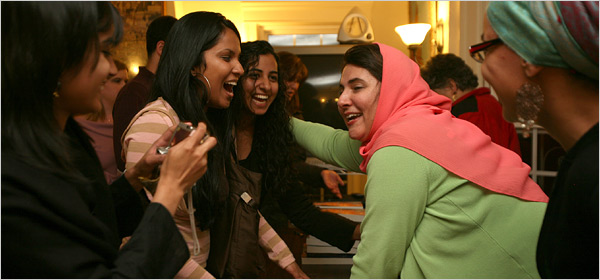Recently published for public consumption, The 500 Most Influential Muslims (PDF) is already causing a stir throughout the web. While many are satisfied with the list’s contents or happy to have made the cut, others are shocked by the absence of particular names. Generally, however, most people are simply confused by the peculiar selection of the list’s 500 names.
One major issue with the book is that it privileges Muslims from the Arab Middle East and Western countries. The list is dominated by names of Muslims from Western and Arab countries. However, this does not necessarily reflect self-centeredness (after all, this list was prepared by Middle Eastern and Western institutions). Instead, it reflects ignorance of Muslims in the rest of the world. Neither Africa nor Southeast Asia receives a dignified mention; nor does the rest of Asia. Apparently, for Georgetown and the Royal Islamic Strategic Studies Centre, Africa is still the Dark Continent! For scholars of Esposito’s stature to ignore the fact that influential Muslims are found wherever Islam is found is hardly acceptable or even believable. It was nothing short of a crime of omission.
Another glaring oddity is the list’s separate category for women. The fact that women were sidelined into their own category reflects mere lip service to women’s equality. The “add women and stir” approach to addressing the gender gap has been a worn out way for a number of decades for those seeking to demonstrate gender-inclusiveness despite their lack of desire to include women as equal partners. The fact that this kind of practice still persists within respected academic institutions is damning, particularly to the study of Islam, and shows a great failure on the part of those leading the editorial process.
To add insult to injury, the list of influential women is remarkably short. The gaping hole that could have been filled with so many of the world’s remarkable Muslim women reflects a lack of recognition and respect shown to Muslim women as leaders and scholars. Women are also completely missing from the book cover, both literally and figuratively relegated to a separate space.
It is undeniable that female scholars and leaders are given less airtime than men throughout the Muslim world. But, more importantly, it is also undeniable that female scholars often outclass their male counterparts. The list thus perpetuates the unfortunate rule that Muslim women will receive neither the mention nor the credit they deserve for their contributions.
At a fundamental level we are unlikely to all agree on who constitutes a “Muslim”, let alone who constitutes an influential one, and in this way all lists like this are an exercise in foolishness. The way that international policy makers see influence is different than the way an average Muslim man or woman is going to see it—each person is influenced in different ways. The book’s key problem is thus its lack of a specific methodology to deal with the concept of influence. Judging from the book’s composition, it appears that no methodology was used at all, which makes it a completely subjective list chosen by people who will have to pick certain people because of political alliances, religious motivations, or a stated mission, such as the promotion of a tolerant Islam.
That said, the book is useful as a general guide to who’s who in the Arab and Western Muslim world. And although the philosophical divisions in the book’s introductory pages lack academic credibility, the classification is nevertheless done in a clear and intelligent way. This should help many Muslims and non-Muslims grapple with the complexity of our incredibly diverse religion.
However, while the book conveys a lot of information, little is authenticated by reliable sources. The list thus operates on the faulty assumption that the editors’ stature ensures the book’s reliability. As a properly researched and referenced book, this would have been a great addition to the bookshelf of anyone interested in notable Muslims.
A next attempt at creating such a list should be named Who’s Who of Islam. It should serve as a guide to important Muslims around the world, listed by country and topic. The list could be carefully divided to represent the reality of Muslim demographics, and regional editors could be used to give a clear picture of the “movers and shakers” in those regions. A side publication could be The Power Brokers in the Muslim World, where the majority of the figures in the Top 50 would be placed. This would better reflect the reality of our world, but would also provide some measure of academic rigor, and make the writing of such a list less of an imprudent undertaking.
Selena Shah is a freelance writer based in the San Francisco Bay Area.





Well, it is a list of “influential” Muslims which kind of implies those who have power already. Like it or not, it only shows that the people who have the most power among Muslims are either Eastern dictarors or in the West.
This list merely shows us how far we have to go, so it can usefully serve as a baseline for our hopefully-progressive social development.
This is hilarious: King Abdullah ???Overjoyed??? About Being Named Most Influential Muslim in the World http://wp.me/pIP1s-6
The top ten is pretty much the “who’s who” of deception, torture, and theft. Nice. The “book” should be titled, “Like It or Not, 500 of the Most Influential Muslims as Noted by Saudi and American Funded Think Tanks”